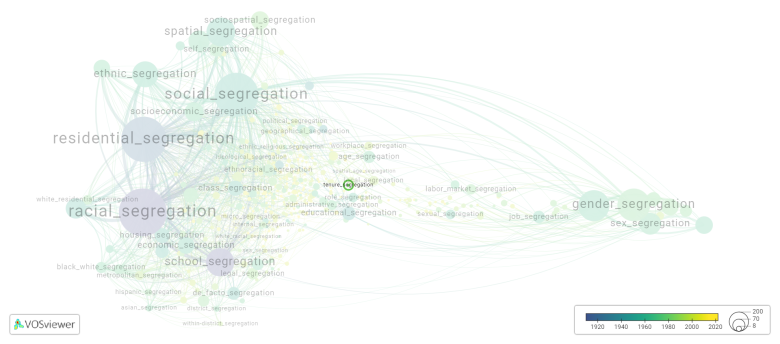Tenure segregation: Difference between revisions
(Creating page) |
(Creating page) |
||
| (One intermediate revision by the same user not shown) | |||
| Line 20: | Line 20: | ||
[[File:tenure_segregation.png|780x780px]] | [[File:tenure_segregation.png|780x780px]] | ||
This visualization is based on the study [[Segregation_Wiki:About| The Multidisciplinary Landscape of Segregation Research]]. | |||
For the complete network of | For the complete network of interrelated segregation forms, please refer to: | ||
* | * [https://tinyurl.com/2235lkhw First year of publication] | ||
* | * [https://tinyurl.com/2d8wg5n3 Louvain clusters] | ||
* | * [https://tinyurl.com/223udk5r Betweenness centrality] | ||
* | * [https://tinyurl.com/244d8unz Disciplines in which segregation forms first emerged (Scopus database).] | ||
==References== | ==References== | ||
==Notes== | ==Notes== | ||
Latest revision as of 07:17, 16 October 2024
Date and country of first publication[1][edit | edit source]
1992
United Kingdom
Definition[edit | edit source]
Tenure segregation refers to the spatial separation of different tenure types, such as owner-occupied housing, rental housing, and social housing within a neighborhood or a city. It refers to the concentration of households of a specific tenure type in certain areas, leading to a lack of diversity and mixture in housing tenures within a community.
Tenure segregation can result from various social, economic, and policy factors. Factors such as income disparities, housing affordability, and housing policies can contribute to the concentration of specific tenure types in certain areas. For example, areas with higher housing costs might have a higher concentration of rental housing, while areas with more affordable housing options may have a higher concentration of owner-occupied housing.
Tenure segregation can have both positive and negative implications. On the positive side, it can provide opportunities for social interaction and support among people with similar housing needs and circumstances. It can also facilitate targeted provision of services and amenities specific to certain tenure types.
However, tenure segregation can also have negative consequences. It can perpetuate inequality and social exclusion by concentrating disadvantaged groups in specific areas. It can create divisions and social barriers between different socioeconomic groups, leading to limited access to resources, opportunities, and social networks. It can also result in the unequal distribution of public services and amenities across neighborhoods.
Efforts to reduce tenure segregation often focus on promoting mixed communities and diverse housing tenures. Strategies may include the development of mixed-tenure housing projects or the implementation of policies and incentives to encourage affordable housing in areas with higher concentrations of owner-occupied housing. The goal is to create more inclusive and socially diverse neighborhoods that offer a range of housing options for different income groups.
See also[edit | edit source]
Related segregation forms[edit | edit source]
Tenure segregation is frequently discussed in the literature with the following segregation forms:
social segregation, occupational segregation

This visualization is based on the study The Multidisciplinary Landscape of Segregation Research.
For the complete network of interrelated segregation forms, please refer to:
References[edit | edit source]
Notes[edit | edit source]
- ↑ Date and country of first publication as informed by the Scopus database (December 2023).
At its current state, this definition has been generated by a Large Language Model (LLM) so far without review by an independent researcher or a member of the curating team of segregation experts that keep the Segregation Wiki online. While we strive for accuracy, we cannot guarantee its reliability, completeness and timeliness. Please use this content with caution and verify information as needed. Also, feel free to improve on the definition as you see fit, including the use of references and other informational resources. We value your input in enhancing the quality and accuracy of the definitions of segregation forms collectively offered in the Segregation Wiki ©.
Tenure segregation appears in the following literature[edit | edit source]
WILLIAMS N.J. (1992). SOCIAL SEGREGATION IN URBAN SCOTLAND. Tijdschrift voor economische en sociale geografie, 83(1), 63-71. https://doi.org/10.1111/j.1467-9663.1992.tb00609.x
Hoff K., Sen A. (2005). Homeownership, community interactions, and segregation. American Economic Review, 95(4), 1167-1189. https://doi.org/10.1257/0002828054825682
